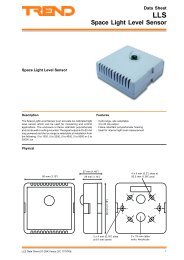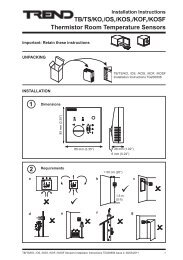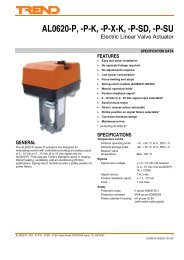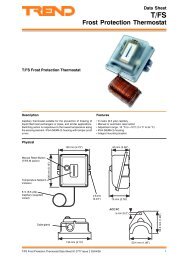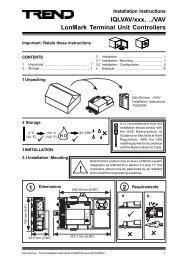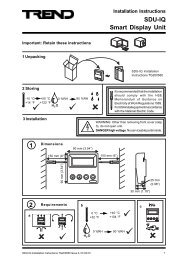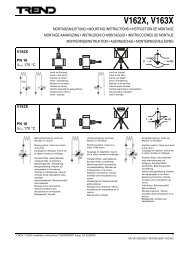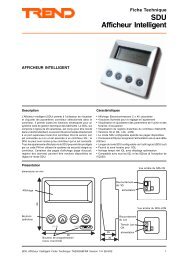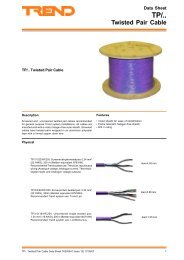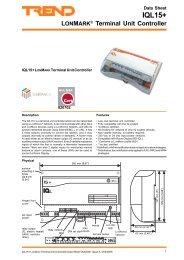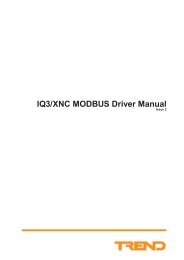Specification sheet (English) - Trend
Specification sheet (English) - Trend
Specification sheet (English) - Trend
You also want an ePaper? Increase the reach of your titles
YUMPU automatically turns print PDFs into web optimized ePapers that Google loves.
IQ23x<br />
Data Sheet<br />
Functionality<br />
The IQ Controller’s functionality can be divided into three sections, strategy, firmware, and hardware.<br />
Strategy<br />
The strategy processes inputs according to a set of instructions<br />
and then outputs signals which can be used to control plant.<br />
Configuration: The IQ23x uses the standard IQ configuration<br />
mode which enables configuration by way of the network, or<br />
the supervisor port. SET can be used to create a strategy data<br />
file (.IQ2) which can then be downloaded to the controller and<br />
subsequently uploaded for backup purposes if connected to the<br />
controller directly, by way of the network or by way of a modem.<br />
A strategy data file from an IQ1xx controller (.IQF) can be<br />
downloaded to an IQ23x and will require modification as<br />
explained in the compatibility section<br />
Modules: The strategy consists of a number of individual<br />
functional blocks known as configuration modules. These<br />
blocks can be linked in various combinations to enable plant to<br />
be controlled in accordance with the building’s requirements.<br />
The table lists the different types of configuration modules and<br />
the number of each type available with IQ23x.<br />
Module Type Number Module Type Number<br />
Sensor 48 Critical Alarm 4<br />
Sensor type 15 Alarm History 20<br />
Loop 32 IC Comms 16<br />
Function 160 Digital Inputs 48<br />
Logic 160 Fast Sequence 8<br />
Driver 32 Zone 5<br />
Knob 30 Schedule 32<br />
Switch 20 Calendar 20<br />
Sensor log 32 User Password 6<br />
Sequence step 400 Sequence time 1 s<br />
Analogue Nodes 255 Digital Nodes 506<br />
Display 200 Directory 40<br />
Page 50 Group 10<br />
Route 50 Destination 7<br />
New Alarm Log 200<br />
Full details of the modules are given in the IQ Configuration<br />
Manual and Addendum. The IQ23x contains the normal IQ2<br />
features as described in IQ Configuration Manual Addendum:<br />
Engineers Journal (J), I/O Summary (i/o) Loader Issue (R(c),’c’<br />
lower case), Serial Number (R(s), ‘s’ lower case), Supply<br />
Frequency Option, Enhanced Logging, Module position, and<br />
Strategy Cleardown. Differences between the modules covered<br />
in the manuals and the IQ23x’s modules are covered below.<br />
Address Module<br />
It has two additional items described below:<br />
default PIN disable: This increases the controller security by<br />
disabling the default PIN. It is accessed using the character<br />
“d”, setting d=1 will disable the default PIN. It may be enabled<br />
by setting d=0 (as long as a valid PIN is used). This change<br />
requires a PIN with level 99. If the default PIN is disabled and<br />
the PIN settings are unknown (e.g PINs forgotten or after<br />
battery replacement), the unit can be restored by clearing the<br />
strategy using the address/baud rate switch zero reset and then<br />
downloading the strategy.<br />
Firmware<br />
Communications: When operating as part of a Building<br />
Management System, the IQ23x will be connected to other<br />
devices by way of the <strong>Trend</strong> Network. This means that<br />
information within the IQ23x can be accessed using one of<br />
the <strong>Trend</strong> supervisor programs, or passed to other <strong>Trend</strong> IQ<br />
controllers using inter‐controller communications, enabling the<br />
sharing of information across the whole system.<br />
When connected to the network the controller can use up to<br />
2 different addresses. One address is for the controller itself,<br />
the second is optional, and is for the supervisor port (locally<br />
connected supervisor). The controller’s address is set by a<br />
switch, and the supervisor port address is set up in the strategy<br />
configuration (address module).<br />
Hardware<br />
Unit: The IQ23x is supplied in a metal enclosure. It has 4<br />
mounting points which are on the same centres as the IQ111+<br />
and IQ131+; they are also the same as those provided by the<br />
IQ111 or IQ131 using the mounting bars. Its footprint is smaller<br />
than IQ111 or IQ131, and the same as the IQ111 or IQ131 with<br />
their mounting bars, but it is 13 mm deeper<br />
Connectors: Two part connectors are used throughout<br />
to facilitate wiring. An earth flange is provided for screen<br />
termination with a special M3 earth stud close to the network<br />
connection, and there are cleats for cable restraint.<br />
Power: 230 Vac 50/60 Hz.<br />
Note that this unit must be earthed (grounded) via the Earth<br />
terminal of the IEC connector.<br />
Fusing: The controller has no replaceable fuses; protection<br />
is provided by means of a self-resetting thermally protected<br />
transformer.<br />
Indicators: LED indicators for receive and transmit network<br />
current flow (RX, TX) and network OK ( ), also for all I/O<br />
channels, power ( ), and fail ( ). See specification section for<br />
details.<br />
Network: The network terminals facilitate connection of 4 wire<br />
cables. The standard <strong>Trend</strong> node features are included (TX,<br />
RX, and network OK, , indicators, bypass relay, and network<br />
alarm generation). There is also the facility for connection of a<br />
supervisor or network display panel to the network by way of<br />
the controller without the need for an additional node controller.<br />
Internal Node: A node controller card may be fitted inside<br />
the unit either as a pre-fitted option, or post-fitted using the<br />
appropriate cables. There is a two pin polarised plug to supply<br />
24 Vdc to the node and a four pin polarised plug which provides<br />
a network connection. There is a set of two pairs of pins<br />
adjacent to the network plug which are normally shorted by two<br />
links; these must be removed when the node is connected. For<br />
an integral node controller to operate the external network must<br />
be connected, or the external network terminals must be linked<br />
(TX to RX).<br />
sUperv port addr: This operates as described in the IQ<br />
Configuration manual addendum with the additional feature that<br />
if the address is set to 120, the supervisor port will be disabled.<br />
This gives increased security. The port can be enabled by<br />
setting the address to another value by configuration or text<br />
comms over the network.<br />
Byte 506, Bit 1<br />
This bit now has the fixed function of ‘IQ1 series simulation of<br />
universal input action’ (see Compatibility section, Firmware).<br />
2 IQ23x Series Controllers Data Sheet TA200538 Issue 2, 18-Jan-2012



